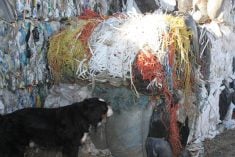SASKATOON – Six months ago, a veterinarian told his local chamber of commerce that it should do something for the community, like build a beef processing plant.
Chamber secretary Gerry Kohuch took Alex Von Dewitz seriously, thinking what the doctor ordered is just what the community needed.
The chamber of commerce hired a consultant and sponsored a public meeting Nov. 15 to propose that Blaine Lake, Sask., become home to a $20 million beef slaughtering and processing plant with 100,000 head per year capacity. The meeting attracted 165 people from north-central Saskatchewan.
Read Also

Message to provincial agriculture ministers: focus on international trade
International trade stakeholders said securing markets in the face of increasing protectionism should be the key priority for Canada’s agriculture ministers.
Organizers are now trying to raise money for a $20,000 feasibility study. Farmers are being asked to contribute $100 each for the study and a business plan. Since the meeting, $5,000 has been raised.
In an interview, Kohuch said the study, intended to be completed by April, will show whether a plant in the region will be able to compete against the international corporations like Cargill, IBP and ConAgra.
“We want to see if it’s a good idea or we should surrender to the cartel, but this plant could be a cartel breaker,” he said.
If the study suggests the plans will work, Kohuch said organizers will visit area communities and ask farmers to get involved.
Money for the plant would be raised 50-50 from producers and corporations, Kohuch said. While a co-operative is being suggested, he said the organizers aren’t “stuck on any economic model.”
Kohuch believes a beef processing plant is feasible at Blaine Lake. It’s at the crossroads of two highways and within an hour or less of three different cities. The town has a good water supply, an upgraded rail bed and it is 80 kilometres to an international airport.
Accept game and exotics
As well, there are 400,000 cattle in the area north of Saskatoon, Kohuch said. The plant could be used for regular beef cattle, but also heavyweights, culls, cows and game animals such as bison, elk and fallow deer.
The community wants to build the plant to European Union standards so meat can be marketed to the EU, Pacific Rim and U.S. markets.
Since Intercontinental Packers shut down its beef killing line in Saskatoon April 1, citing intense competition from the American companies, beef producers in the north-central part of the province have had to ship their animals for slaughter to the Western Canadian Beef Packing Plant in Moose Jaw.














